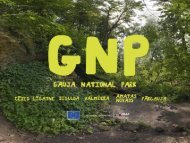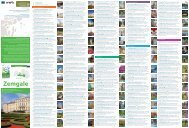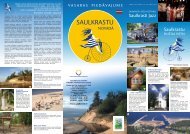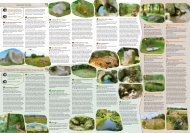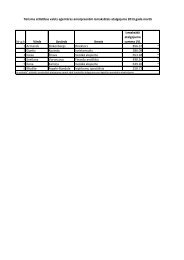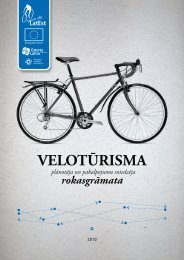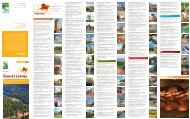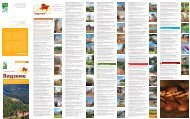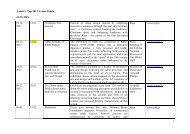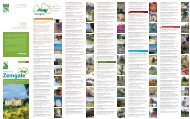City on the wave! - Latvian Tourism Development Agency
City on the wave! - Latvian Tourism Development Agency
City on the wave! - Latvian Tourism Development Agency
Create successful ePaper yourself
Turn your PDF publications into a flip-book with our unique Google optimized e-Paper software.
20 / JŪRMALA<br />
sightseeing in <strong>the</strong><br />
centRe of JŪRMALA<br />
See <strong>the</strong> locati<strong>on</strong>s <strong>on</strong> Jurmala Centre map<br />
1 squARe oPPosiTe TRAin sTATi<strong>on</strong><br />
MAJoRi (Jomas iela 32)<br />
Once it was <strong>the</strong> beginning of Jomas street. In<br />
1877 <strong>the</strong>re was a first pharmacy that burnt down<br />
in <strong>the</strong> great fire in 1913. In 1953 a sculpture by<br />
L.Kristovskis “Lāčplēsis” was put up in square.<br />
The square and <strong>the</strong> sculpture were renovated in<br />
2003, but in 2006 a fountain “The Horiz<strong>on</strong>” was<br />
opened here.<br />
2 hoTeL “MAJoRi” (Jomas iela 29)<br />
Built in 1925 in traditi<strong>on</strong>al style of historism,<br />
architect – A.Medlinger. Initially <strong>the</strong>re were 100<br />
rooms in <strong>the</strong> building, but around it – a park with<br />
<strong>the</strong> fountains. Due to crisis in 1932 <strong>the</strong> hotel was<br />
aucti<strong>on</strong>ed. The splendid furniture and pieces of<br />
art were taken to <strong>the</strong> castle of Sigulda. Now <strong>the</strong><br />
hotel is closed.<br />
3 The house oF AsPAziJA (z. Meierovica<br />
prospekts 20, Tel. +371 67769445)<br />
See <strong>the</strong> descripti<strong>on</strong> in <strong>the</strong> chapter “Art & History”<br />
4 DuBuLTi LuTheRAn chuRch<br />
(Baznīcas iela 13, Tel. +371 67755801)<br />
Built in 1907 – 1909. Architect W.Bokslaf. Original<br />
art nouveau building with traits of nati<strong>on</strong>al<br />
romanticism. In 1962 – 1990 Dubulti Lu<strong>the</strong>ran<br />
church was nati<strong>on</strong>alized and Jurmala History<br />
and art museum was operating in <strong>the</strong> building.<br />
Since 1990 <strong>the</strong> church has been returned to <strong>the</strong><br />
Lu<strong>the</strong>ran c<strong>on</strong>gregati<strong>on</strong>.<br />
www.tourism.jurmala.lv<br />
Jomas street<br />
5 oRThoDox chuRch oF<br />
sT.vLADiMiR in DuBuLTi.<br />
(Strēlnieku prospekts 26,<br />
T. +371 67769667)<br />
Built in 1896. In lateral building extensi<strong>on</strong> living<br />
premises are arranged. It was managed to save art<br />
m<strong>on</strong>uments in <strong>the</strong> interior.<br />
6 FoRMeR ResoRT hoTeL<br />
MARienBāDe<br />
(z. Meierovica prospekts 41/43)<br />
The first resort hotel in Jurmala, built in 1870. The<br />
resort became popular thanks to <strong>the</strong> doctor J.C.<br />
Nordstrom, who started to use <strong>the</strong> climate <strong>the</strong>rapy.<br />
The patients had to do l<strong>on</strong>g walk <strong>on</strong> bare feet<br />
al<strong>on</strong>g <strong>the</strong> sea, as well as swim in <strong>the</strong> sea. During<br />
<strong>the</strong> World War II, almost whole principal building<br />
of <strong>the</strong> health resort was demolished, but later it<br />
was rebuilt. Today <strong>on</strong>ly <strong>the</strong> tower gallery annexes<br />
and <strong>the</strong> entrance gate has remained its original<br />
appearance.<br />
7 DweLLinG house (Jūras iela 2)<br />
Built around 1909 and is <strong>the</strong> richest in details<br />
and most m<strong>on</strong>umental in its c<strong>on</strong>structi<strong>on</strong>s<br />
wooden house of neoclassicism in Jurmala. Its’<br />
historical façade and interior was renovated<br />
in 1997. The main facade is decorated with<br />
medalli<strong>on</strong> with a woman’s portrait low relief.<br />
Artist E.Krūmiņš renovated <strong>the</strong> lost medalli<strong>on</strong><br />
using <strong>the</strong> portrait of <strong>the</strong> new owner of <strong>the</strong><br />
house.<br />
Jomas street – <strong>on</strong>e of <strong>the</strong> central and oldest streets of Jurmala with<br />
restaurants, summer terraces, hotels and cafés with live music.<br />
The name of <strong>the</strong> street in <strong>Latvian</strong> means parallel lines in <strong>the</strong> sand dunes.<br />
Nowadays <strong>the</strong>re is a traditi<strong>on</strong> to celebrate <strong>the</strong> first pedestrian street’s in<br />
Jurmala - Jomas street’s - festival.<br />
8 JŪRAs sTReeT<br />
Jūras street is closest parallel street to <strong>the</strong> sea that is<br />
bordering with dunes. Even in <strong>the</strong> middle of 19th<br />
century <strong>the</strong> area where streets Jūras and Jomas<br />
now are was covered with wet forest. In <strong>the</strong> sec<strong>on</strong>d<br />
part of <strong>the</strong> 19th century it was allowed to build<br />
dwelling and boarding houses here, and rich people<br />
started to build houses <strong>on</strong> large sites. Almost all<br />
architectural styles of Jurmala can be observed here,<br />
many of buildings are architectural m<strong>on</strong>uments.<br />
9 DweLLinG house (Jūras iela 6)<br />
Built in 1913 this house is a typical art nouveau<br />
building with very expressive asymmetric compositi<strong>on</strong><br />
of dimensi<strong>on</strong>s, and with graceful gazebo that<br />
counterbalances <strong>the</strong> dimensi<strong>on</strong>s of <strong>the</strong> house. In<br />
window openings and roof’s top decorati<strong>on</strong>s rich<br />
woodcarving decorati<strong>on</strong>s are used, but in verandas’<br />
windows – arched glass, all those things are very<br />
characteristic of Jurmala’s wooden architecture.<br />
10 BenJAMins’ house (Jūras iela 13)<br />
Built in 1939, architect – L.Vitlin. During <strong>the</strong><br />
first period of Latvia’s independence, <strong>the</strong> famous<br />
publisher and social worker E.Benjamina had a<br />
summer cottage here, and it is <strong>on</strong>e of <strong>the</strong> most<br />
impressive buildings in Jurmala. The elegance<br />
of <strong>the</strong> house is stressed by <strong>the</strong> natural st<strong>on</strong>e<br />
panelling with its evidence of World War II: darker<br />
coloured areas that were a demand for air defence<br />
requirements. The interior of <strong>the</strong> house is also<br />
kept, as almost 50 years after <strong>the</strong> war <strong>the</strong> House<br />
1 4<br />
<strong>on</strong> Benjamins served as summer residency for<br />
authorities of <strong>the</strong> Soviet Uni<strong>on</strong>. Today many pieces<br />
of articstic property of <strong>the</strong> end of 19th century<br />
and beginning of 20th century still can be found<br />
<strong>the</strong>re. A fence that surrounds <strong>the</strong> house is <strong>the</strong> most<br />
magnificent in Jurmala.<br />
11 scuLPTuRe BRuņuRuPucis (<strong>the</strong> Turtle)<br />
Sculptor - J.Bārda. One of <strong>the</strong> most popular tourism<br />
objects by which <strong>the</strong> photos are taken. The turtle<br />
symbolizes l<strong>on</strong>g life.<br />
12 seA PAviLi<strong>on</strong> (Tirgoņu iela 1)<br />
Architect - A.Medlinger. Built in 1909 in <strong>the</strong> style<br />
of historism to be used for leisure activities and<br />
recreati<strong>on</strong>. One of <strong>the</strong> most prominent social centres<br />
for spendind leisure time of <strong>the</strong> 20th century<br />
that is located in <strong>the</strong> dune area. Pavili<strong>on</strong> offered<br />
restaurant and popular whirling dance floor. One of<br />
<strong>the</strong> most famous visitors of <strong>the</strong> pavili<strong>on</strong> is <strong>the</strong> King<br />
of Sweden Gustav V, who was <strong>the</strong>re in summer of<br />
1929. The building was renovated in 2005.<br />
13 FoRMeR BATh-house oF e. Rācene<br />
(Pilsoņu iela 1)<br />
Built during years 1911 to 1916. All year round it<br />
offered different baths: heated sea water, carb<strong>on</strong>ic<br />
acid, oxygenous and balsam of fir baths.<br />
In <strong>the</strong> Soviet times, it served as <strong>the</strong> resort’s spa<br />
centre – <strong>on</strong>e of <strong>the</strong> best medical instituti<strong>on</strong>s with<br />
<strong>the</strong> best facilities in former Jurmala. In 2003 <strong>the</strong><br />
house was renovated and regained its former look.



